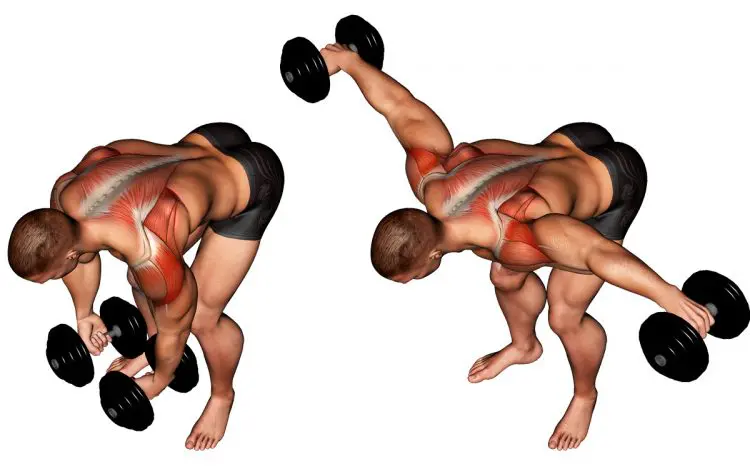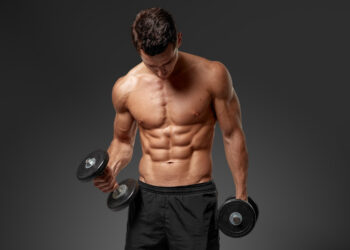The dumbbell rear lateral raise is just one of the many great isolation exercises that help to develop the upper posterior (backside of the body) muscles.
The rear deltoids and upper body muscles, in general, are commonly neglected for many reasons. However, they contribute greatly to postural health, lifting posture, and aesthetics. Therefore, taking the time to focus on these muscles is non-negotiable.
In this guide, we’ve explained how to do this exercise with tips, variations, and how to most effectively include it in your training.
Muscles Worked
Deltoid posterior
The deltoid posterior is part of the three shoulder muscles and unlike the other two heads, it’s located on the rear side of the body. Because of its anatomical placement, the rear delt fibers allows us to draw the arms behind the body and pull the scapula or shoulder blades back.

Deltoid Lateral
Also known as the outer or side deltoids, the lateral shoulder head forms the roundness to the upper torso and creates a wider looking appearance to the upper body. Unlike the other shoulder heads, deltoids lateral abducts or raises the arms up laterally between 15 and 100 degrees. Deltoids lateral is targeted indirectly during dumbbell lateral raises.
Infraspinatus
The infraspinatus belongs to a group of muscles in the rotator cuff that help us to maintain shoulder motion and stability.
Level Up Your Fitness: Join our 💪 strong community in Fitness Volt Newsletter. Get daily inspiration, expert-backed workouts, nutrition tips, the latest in strength sports, and the support you need to reach your goals. Subscribe for free!
Teres Minor
Like the infraspinatus, the teres minor is grouped with the rotator cuff muscles. It extends from the scapula to the humerus and helps to make arm movement possible.
Trapezius Lower Fibers
The lowermost section of trapezius muscles push the scapula down and help lift the scapula with help from the upper fibers.
Trapezius Middle Fibers
Sandwiched between the upper and lower traps muscles, middle fibers are responsible for retraction of the shoulder blades.
How To Do The Dumbbell Rear Lateral Raise
While the dumbbell rear lateral raise is not a complex exercise, we’ve provided step-by-step instructions.
- While holding a dumbbell in each hand, brace your core and lean forward at the hips but not too far to where the upper body is parallel to the floor. Keep your back straight.
- Bend your knees and elbows slightly.
- Raise the dumbbells up and out to the sides keeping the arms in one position and contract the rear delts.
- Lower the weights and repeat.
Here’s a video example…
Dumbbell Rear Lateral Raise tips
- There’s no need to use max weights for this movement. Not only is it dangerous but you most likely will not be able to effectively use a full range of motion anyway in this position.
- Do not raise your arms out in front of you or too far back. Your arms should move in a comfortable direction relative to how you’re positioned.
- You can also do this exercise using one arm at a time and/or a kettlebell to change things up.
3 Variations/Alternatives
While the basic standing exercise is effective, we also recommend these variations/alternatives that have their own advantages.
1. Chest-supported/incline
Chest-supported variations are great because your upper body is stabilized and you’re less likely to cheat which you probably won’t be able to use as much weight.
Level Up Your Fitness: Join our 💪 strong community in Fitness Volt Newsletter. Get daily inspiration, expert-backed workouts, nutrition tips, the latest in strength sports, and the support you need to reach your goals. Subscribe for free!
2. Cable rear delt raise
Any exercise using dumbbells can be done with cables. The advantage of using cables is that there’s constant tension on the muscles regardless of your body position and this allows for more options.
The cable rear-drive and other similar exercises are also great.
WATCH: The Best Way to Build Your Rear Delts – Not Reverse Flys
3. Bent-over delt/high row
The bent-over row is just an all-around superior posterior chain movement. But you can emphasize the upper back and delts better by rowing into your delts as opposed to lower on the torso like with the conventional bent-over row.
Rows also allow you to use more weight than a raise so it’s a good strength and mass builder.
Kroc Rows: Muscles Worked, Benefits, How-to, and Alternatives
Using The Dumbbell Rear Raise Into Your Training Routine
Because the shoulders are composed of three separate heads, it’s important to isolate all three.
The dumbbell rear lateral raise is one way to train the posterior delts and it’s good enough as a standalone exercise to target the rear delt head. If your rear delts are underdeveloped, you may also want to include another isolation exercise in the same workout as well.
Sets/reps
While this is not set in stone and you’re free to experiment and try different set and rep ranges, we recommend anywhere from 2-4 sets of 8-20 reps for those not as experienced. Of course, you can mix up the reps depending on your goals.
Wrapping Up
The dumbbell rear lateral raise makes for an ideal addition to your posterior deltoid workouts. It’s an effective isolation movement that anyone can do safely and effectively and can be combined with other shoulder exercises to build round delts.
Interested in measuring your progress? Check out our strength standards for Dumbbell Reverse Fly, Dumbbell Lateral Raise, Bent Over Row.








